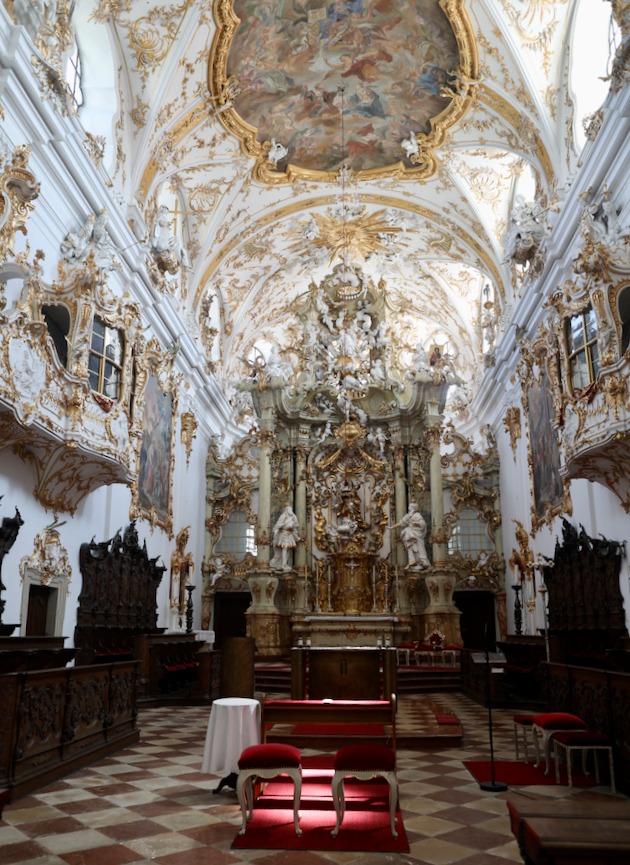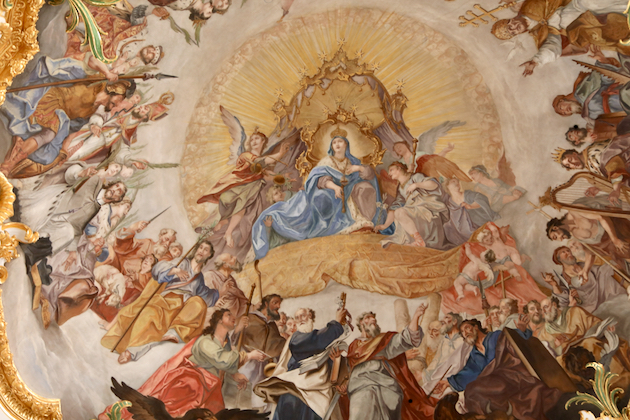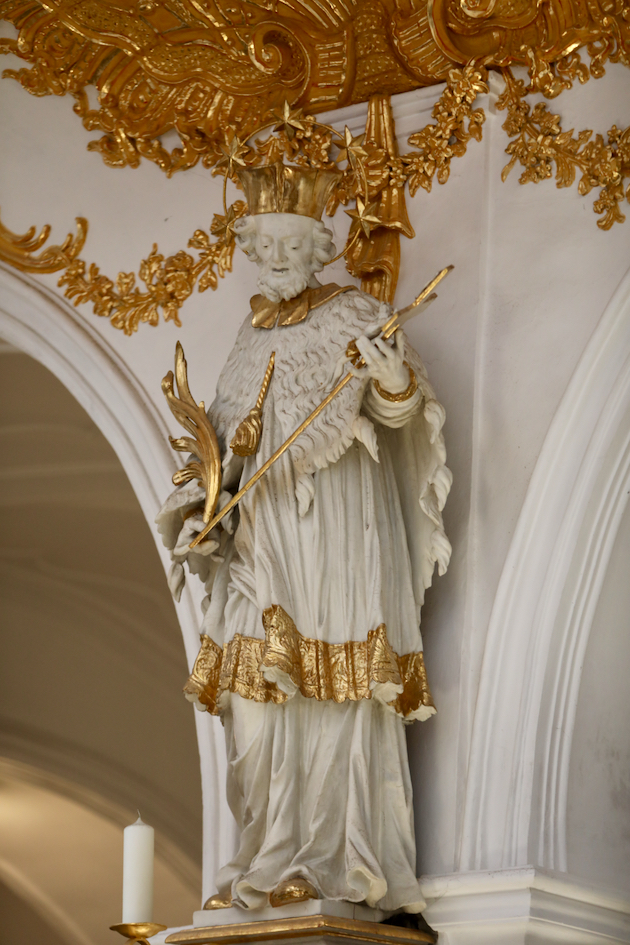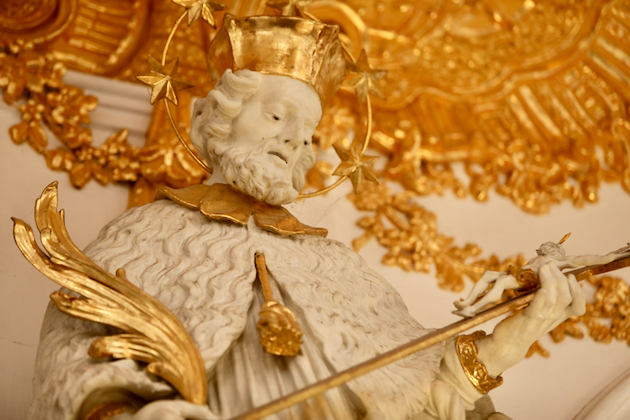
Few places are so suggestive of the legacy of the Holy Roman Empire as Regensburg. Today a provincial Bavarian town, this city for centuries played a major role in German and European affairs. Now what is characteristic of the art of Regensburg are the traces of the course of history one finds everywhere, but especially in certain of the main churches. Just as in Rome itself, Regensburg’s older churches embody a succession of styles from the early Middle Ages, or even Roman times, to the late baroque. We have previously looked at the former abbey of St. Emmeram.1) Let’s consider another monument to the city’s age of glory: the “Alte Kapelle” (the “Ancient (or Old) Chapel”) – or, more formally, the “Collegiate Church (Stift) of Our Lady at the Old Chapel in Regensburg.”
Like St. Emmeram, the Alte Kapelle claims a heritage from pre-Carolingian times – supposedly it was the palace Chapel of the Dukes of Bavaria and the first Christian church built on the lands of that tribe. What is certain, however, is that the emperor Louis the German (ruling from 826 or 843 to 876) specifically founded a collegiate church attached to his palace using ancient Roman materials. Indeed, the ninth century was a period of great significance for Regensburg. Louis the German ruled from here; the emperor Arnulf is buried in the city. After a period of troubles, the city recovered its glory under the sainted Imperial couple Henry II and Kunigunda (ruled 1002 – 1024). They reestablished and rebuilt the Alte Kapelle in its current form.
Regensburg flourished through the 13th century – among other things, a stone bridge was built that set the pattern for many others, notably that of Prague. Regensburg became a free imperial city. However, by the 15th century the city had been surpassed within the empire both as a commercial and political center. The Reformation also inflicted wounds. The city itself became Protestant. But, in a situation characteristic of the later Holy Roman Empire, much of the city’s territory remained in the hands of Catholic institutions: the cathedral, various monasteries and the collegiate churches(like the Alte Kapelle). And all was surrounded by the domains of the much more significant Duchy, and later Electorate, of Bavaria. Nevertheless, Regensburg retained some lingering significance as an imperial center. For example, Don Juan of Austria was born here following a visit of the emperor Charles V…
Later the “perpetual imperial diet” (Immerwährender Reichstag) was established in Regensburg between 1663 and 1806 (the end of the Empire). The perpetual Imperial diet was a kind of parliament of the ambassadors of the German states. It was in connection with his duties as commissioner of the diet that in 1748 the prince of Thurn and Taxis moved to Regensburg, where his descendants reside even to the present day.
The imperial legacy of Regensburg concludes with the inglorious figure of Carl Theodor von Dalberg (1744-1817). He was a prelate very much to the taste of the late 18th century: a suave presence in the salons, archchancellor of the Empire, a possessor of multiple benefices: Regensburg, Mainz, Worms, Constance. Later he became one of the leading toadies of Napoleon and the last bishop of Germany to rule over a secular state. And he ended his days, stripped of all his secular possessions, as the bishop of Regensburg in 1817.

(Above) This photo shows the exterior of the Alte Kapelle as it appeared around 1980. From left to right we see the high 15th century Gothic choir, then the nave dating to 1000-1020 and finally the tower rebuilt in the 12th/13th centuries. And all is surrounded by walls and windows that have been redone in the forms of the 18th century.

The exterior does not prepare us for the dazzling white and gold interior. Alongside the Wieskirche and the Asamkirche it is one of the most spectacular late baroque/rococo spaces in Bavaria. Unlike these, however, the Alte Kapelle is not a “work of all the arts,” uniting decoration and architecture. Rather, the lavish new decor was applied to a much more ancient church.

The double-headed eagle of the Holy Roman Empire bearing the coat of arms of Bavaria – a reference to Emperer Henry II who refounded the collegiate church. He had been the duke of Bavaria prior to his coronation as king of Germany, and later Roman emperor.

(Above and below) The bulk of this immense decorative project was accomplished after 1750. The Alte Kapelle unites for almost the last time representatives of the disciplines so often encountered in late baroque interiors in Bavaria : a stucco specialist from Wessobrunn (Anton Landes), painters from Augsburg ( Christoph Thomas Scheffler and Gottfried Bernard Götz) and a local sculptor (Simon Sorg).


The Virgin Mary revered by the saints – painting by Christoph Thomas Scheffler.

(Above and below) Focal point of the church is the main altar with the tabernacle and statue of the Virgin. On either side are Saints Henry and Kunigunda, the imperial refounders of the Alte Kapelle. Much of their work still remains under the 18th century decoration.


In keeping with the dedication of the church proclaimed on the reredos, the Holy Spirit and God the Father hover above the Virgin and the Christ Child.

The stucco work by Anton Landes is overwhelming in its richness and complexity. It is no wonder that the Alte Kapelle lately seems to have found a niche as a wedding venue.


(Above and below) St. John Nepomuk (Nepomucene) was frequently encountered both in and outside of churches throught the Catholic regions of the Holy Roman Empire.

See generally Betz, Karl-Heinz. Die Stiftskirche unserer Lieben Frau zur Alten Kapelle in Regensburg, (4th Edition, 1979, Verlag Schnell & Steiner, Munich/Zurich )
- The Society of St Hugh of Cluny, On the Trail of the Holy Roman Empire II: the Asam Brothers.(6/19/2021)
Related Articles
1 user responded in this post